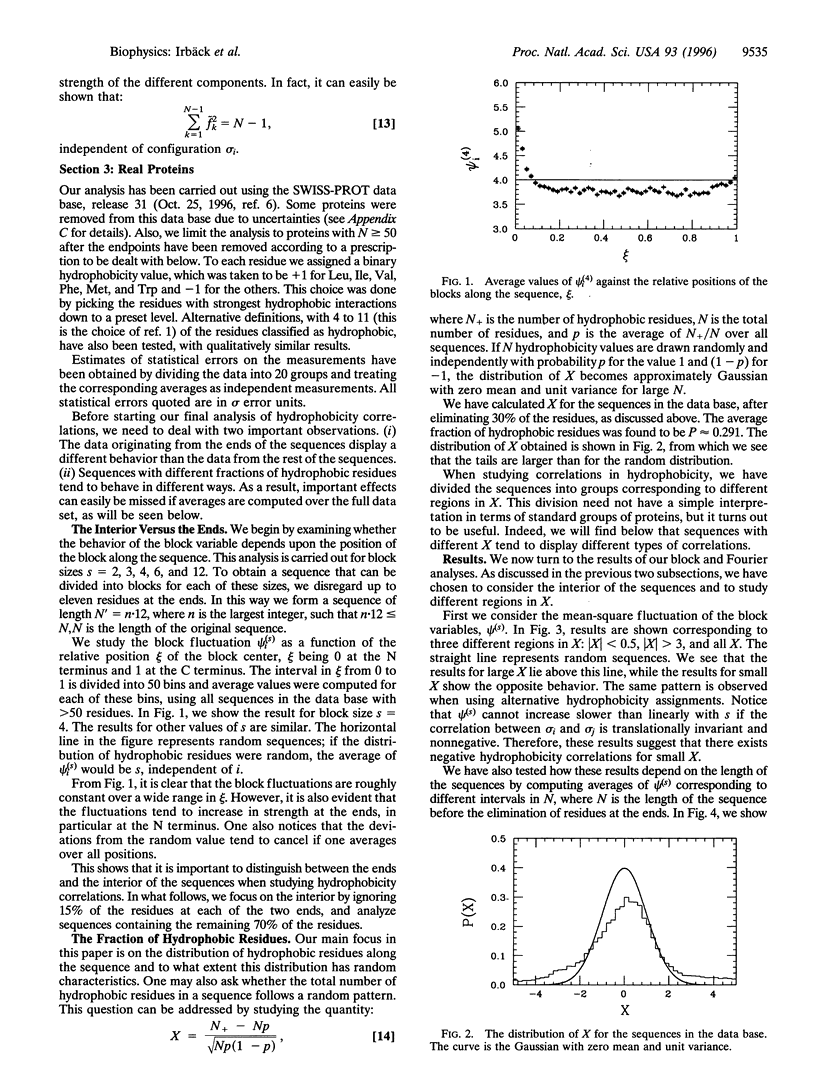Abstract
The question of whether proteins originate from random sequences of amino acids is addressed. A statistical analysis is performed in terms of blocked and random walk values formed by binary hydrophobic assignments of the amino acids along the protein chains. Theoretical expectations of these variables from random distributions of hydrophobicities are compared with those obtained from functional proteins. The results, which are based upon proteins in the SWISS-PROT data base, convincingly show that the amino acid sequences in proteins differ from what is expected from random sequences in a statistically significant way. By performing Fourier transforms on the random walks, one obtains additional evidence for nonrandomness of the distributions. We have also analyzed results from a synthetic model containing only two amino acid types, hydrophobic and hydrophilic. With reasonable criteria on good folding properties in terms of thermodynamical and kinetic behavior, sequences that fold well are isolated. Performing the same statistical analysis on the sequences that fold well indicates similar deviations from randomness as for the functional proteins. The deviations from randomness can be interpreted as originating from anticorrelations in terms of an Ising spin model for the hydrophobicities. Our results, which differ from some previous investigations using other methods, might have impact on how permissive with respect to sequence specificity protein folding process is-only sequences with nonrandom hydrophobicity distributions fold well. Other distributions give rise to energy landscapes with poor folding properties and hence did not survive the evolution.
Full text
PDF





Selected References
These references are in PubMed. This may not be the complete list of references from this article.
- Bairoch A., Boeckmann B. The SWISS-PROT protein sequence data bank: current status. Nucleic Acids Res. 1994 Sep;22(17):3578–3580. [PMC free article] [PubMed] [Google Scholar]
- Bernstein F. C., Koetzle T. F., Williams G. J., Meyer E. F., Jr, Brice M. D., Rodgers J. R., Kennard O., Shimanouchi T., Tasumi M. The Protein Data Bank: a computer-based archival file for macromolecular structures. J Mol Biol. 1977 May 25;112(3):535–542. doi: 10.1016/s0022-2836(77)80200-3. [DOI] [PubMed] [Google Scholar]
- Eisenberg D., Weiss R. M., Terwilliger T. C. The hydrophobic moment detects periodicity in protein hydrophobicity. Proc Natl Acad Sci U S A. 1984 Jan;81(1):140–144. doi: 10.1073/pnas.81.1.140. [DOI] [PMC free article] [PubMed] [Google Scholar]
- Head-Gordon T, Stillinger FH. Optimal neural networks for protein-structure prediction. Phys Rev E Stat Phys Plasmas Fluids Relat Interdiscip Topics. 1993 Aug;48(2):1502–1515. doi: 10.1103/physreve.48.1502. [DOI] [PubMed] [Google Scholar]
- Hobohm U., Sander C. Enlarged representative set of protein structures. Protein Sci. 1994 Mar;3(3):522–524. doi: 10.1002/pro.5560030317. [DOI] [PMC free article] [PubMed] [Google Scholar]
- Hobohm U., Scharf M., Schneider R., Sander C. Selection of representative protein data sets. Protein Sci. 1992 Mar;1(3):409–417. doi: 10.1002/pro.5560010313. [DOI] [PMC free article] [PubMed] [Google Scholar]
- Pande V. S., Grosberg A. Y., Tanaka T. Nonrandomness in protein sequences: evidence for a physically driven stage of evolution? Proc Natl Acad Sci U S A. 1994 Dec 20;91(26):12972–12975. doi: 10.1073/pnas.91.26.12972. [DOI] [PMC free article] [PubMed] [Google Scholar]
- Sali A., Shakhnovich E., Karplus M. Kinetics of protein folding. A lattice model study of the requirements for folding to the native state. J Mol Biol. 1994 Feb 4;235(5):1614–1636. doi: 10.1006/jmbi.1994.1110. [DOI] [PubMed] [Google Scholar]
- Shakhnovich E. I., Gutin A. M. Engineering of stable and fast-folding sequences of model proteins. Proc Natl Acad Sci U S A. 1993 Aug 1;90(15):7195–7199. doi: 10.1073/pnas.90.15.7195. [DOI] [PMC free article] [PubMed] [Google Scholar]
- Stillinger FH, Head-Gordon T, Hirshfeld CL. Toy model for protein folding. Phys Rev E Stat Phys Plasmas Fluids Relat Interdiscip Topics. 1993 Aug;48(2):1469–1477. doi: 10.1103/physreve.48.1469. [DOI] [PubMed] [Google Scholar]
- White S. H., Jacobs R. E. Statistical distribution of hydrophobic residues along the length of protein chains. Implications for protein folding and evolution. Biophys J. 1990 Apr;57(4):911–921. doi: 10.1016/S0006-3495(90)82611-4. [DOI] [PMC free article] [PubMed] [Google Scholar]


